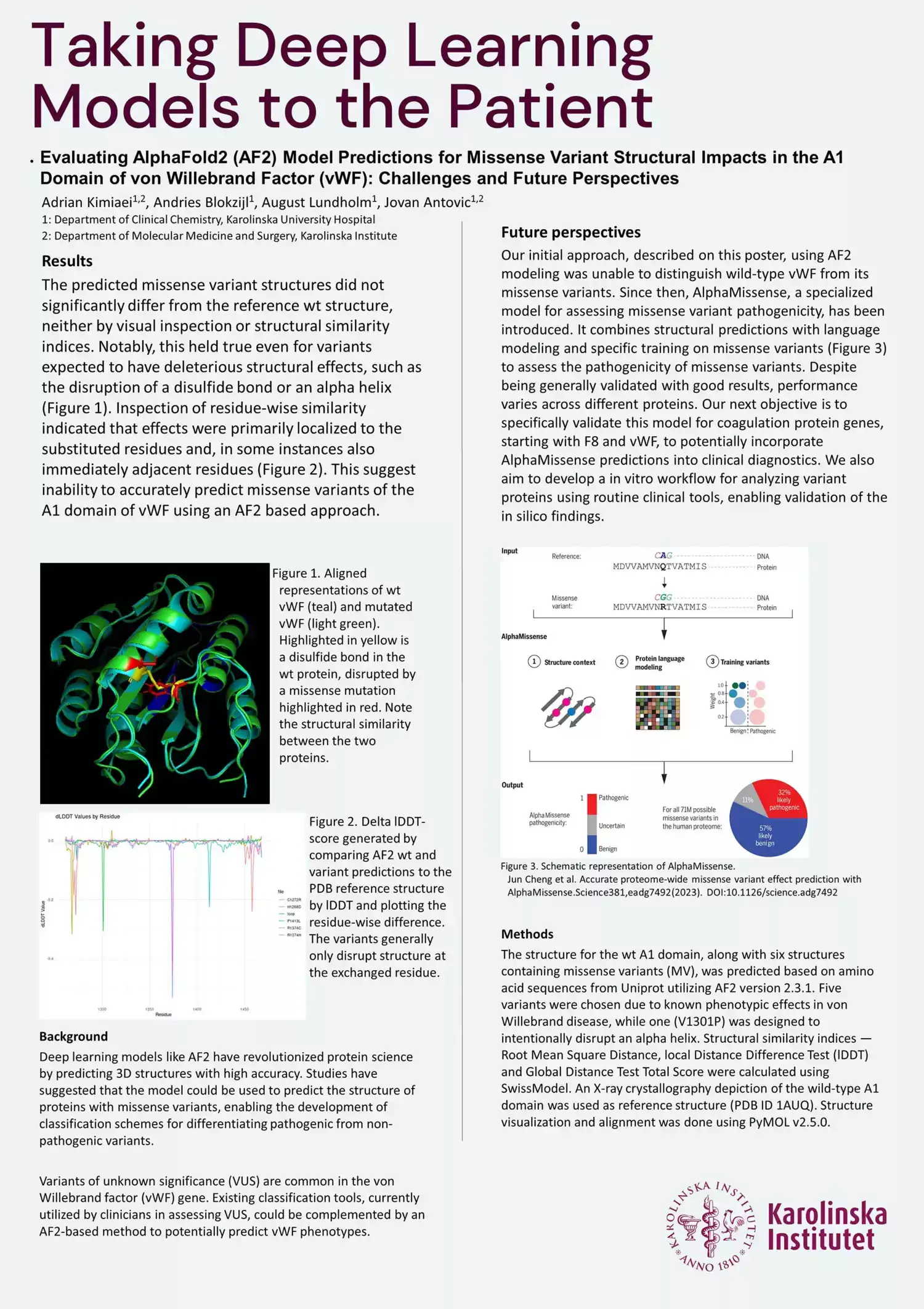Poster 11 - Adrian Kimiaei, Clinical Chemistry and Blood Coagulation
MMK Department's Day 2024

Adrian Kimiaei, Clinical Chemistry and Blood Coagulation
Title: Taking Deep Learning Models to the Patient
Scientific Summary
AlphaFold2 cannot be used to classify the pathogenicity of missense variants in the A1 domain of von Willebrand factor
Background
AlphaFold2 (AF2) has revolutionized protein science by predicting 3D structures with high accuracy [1]. It has been suggested that AF2 could assess the structural consequences of missense variants (MVs), potentially aiding in phenotype prediction [2].
While some studies report negative results in using AF2 for missense prediction [3, 4], another article suggests a strong correlation between AF2-predicted and experimental MV structures across a large set of protein pairs [5]. In another study, a classification scheme using AF2 and biological knowledge achieved over 90% accuracy in differentiating pathogenic from non-pathogenic variants in a histone methyltransferase gene [6].
Variants of unknown pathogenicity are common in the von Willebrand factor (vWF) gene. Existing classification tools could be complemented by an AF2-based method to potentially predict vWF phenotypes.
Aim
This in silico study aimed to design a classification tool based on AF2 structure predictions for pathogenicity prediction of variants in the A1 domain of the vWF.
Method
The structure for the wild-type (wt) A1 domain, along with six structures containing missense variants (MV), was predicted based on amino acid sequences from Uniprot, utilizing AlphaFold2 (AF2) version 2.3.1 [7]. Five variants were chosen due to known phenotypic effects in von Willebrand disease, while one (V1301P) was designed to intentionally disrupt an alpha helix. Structural similarity indices (SSIs) — Root Mean Square Distance, local Distance Difference Test (lDDT) and Global Distance Test, Total Score were calculated using SwissModel [8]. An X-ray crystallography depiction of the wild-type A1 domain was used as reference structure (PDB ID 1AUQ). Structure visualization and alignment was done using PyMOL v2.5.0.
Results
The predicted wt structure and the reference wt structure showed strong agreement. SSIs for the predicted MV structures did not significantly differ from those of the predicted wt structure. Visual inspection corroborated these findings, revealing minimal structural impact from the missense variants. Notably, this held true even for variants expected to have deleterious structural effects, such as the disruption of a disulfide bond or an alpha helix. Inspection of residue-wise lDDT indicated that effects were primarily localized to the substituted residues and, in some instances also immediately adjacent residues.
Discussion
As the MV predictions did not significantly differ in structure from the wt prediction, it was not possible to develop a classification scheme. Several factors may explain why even disease-causing variants show structural similarity. For instance, effects may not solely manifest at the structural level but could impact post-translational modifications or influence activation and restructuring effects in vivo. Additionally, the variants might interfere with interdomain interactions or multimerization, effects not captured by our methodology. The possibility of model failure, i.e., AlphaFold2's inability to accurately predict the MV structures, also cannot be entirely dismissed.
Although the approach was unsuccessful for the A1 domain of vWF, MVs of unknown pathogenicity appear in other proteins as well. Future research could consider applying this methodology to proteins that are structurally simpler than vWF.
References:
1. Jumper, J., Evans, R., Pritzel, A. et al. Highly accurate protein structure prediction with AlphaFold. Nature 596, 583–589 (2021). https://doi.org/10.1038/s41586-021-03819-2
2. Yang, Z., Zeng, X., Zhao, Y. et al. AlphaFold2 and its applications in the fields of biology and medicine. Sig Transduct Target Ther 8, 115 (2023). https://doi.org/10.1038/s41392-023-01381-z
3. Buel, G.R., Walters, K.J. Can AlphaFold2 predict the impact of missense mutations on structure?. Nat Struct Mol Biol 29, 1–2 (2022). https://doi.org/10.1038/s41594-021-00714-2
4. Pak MA, Markhieva KA, Novikova MS, Petrov DS, Vorobyev IS, et al. (2023) Using AlphaFold to predict the impact of single mutations on protein stability and function. PLOS ONE 18(3): e0282689. https://doi.org/10.1371/journal.pone.0282689
5. McBride JM, Polev K, Abdirasulov A, Reinharz V, Grzybowski BA, Tlusty T. AlphaFold2 Can Predict Single-Mutation Effects. Phys Rev Lett. 2023 Nov;131(21):218401.
6. Reynisdottir T, Anderson KJ, Boukas L, Bjornsson HT (2022) Missense variants causing Wiedemann-Steiner syndrome preferentially occur in the KMT2A-CXXC domain and are accurately classified using AlphaFold2. PLOS Genetics 18(6): e1010278. https://doi.org/10.1371/journal.pgen.1010278
